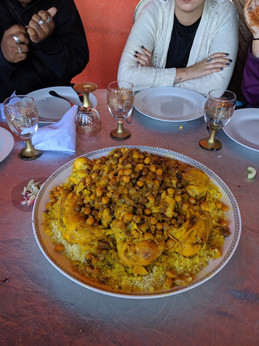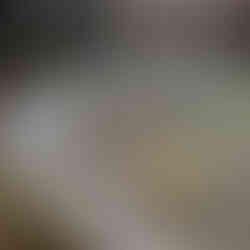Kuli!
- jasafox
- Jan 1, 2020
- 3 min read
Updated: Feb 3, 2020
Kuli is a command in Darija. It literally means "eat!" If you're directing the command to a woman, you say kuli. That's what my host mom says to me every meal we eat together. If you're telling a guy to eat more, you say kul. Both Aaron and I get told to eat, eat, eat by Moroccans no matter where, when or what we're eating. One Moroccan explained to me that if they let us go back to America skinny, our friends and family back home won't think they were hospitable enough here.
What I say (many times a day, when told "kuli") is "Safi, (finished) "shbat" (I'm full), 7amdullah (thanks to God). I often string all three terms together, accompanied by a slashing gesture with my hands, to insist that really, I can’t take another bite.
The culture surrounding eating and food in Morocco is much different in the US. Meals are more leisurely and happen four times a day instead of three: breakfast, lunch, tea time (called Kaskrut) and dinner. Tea is always served with breakfast and Kaskrut, but also sometimes with lunch and dinner. Moroccans tend to eat meals later than we’re used to eating in the US, so sometimes lunch happens closer to 4 or 5 pm and dinner anywhere from 9 pm to midnight. Lunch is the biggest meal of the day, and every lunch I’ve experienced in a Moroccan home has been something delicious and homemade. Food is eaten with your hands and bread instead of with cutlery.
Breakfast (L'futr) is typically a light meal of tea, some sort of bread (khobz in Darija), cheese, olives, and maybe eggs if you’re lucky. I could seriously write an entire blog post just on the different types of bread you can find in Morocco - there’s milwe, which is a pastry-like flat bread, hrsha, which is a cornbread-like flatbread, whole grain bread, white bread, sweet bread dotted with sesame seeds, baguettes, round loaves, thick pita-like bread….the list goes on and on. I never thought I, as an intense carb lover, would be so tired of bread, but I wouldn’t mind if I never see another piece.

Lunch (L'ghdda) is the heaviest meal of the day in Morocco, and is often some sort of salad (I’ve been served cucumber salad, green salad, fruit salad and pasta salad), followed by a main course (often a tajine or some sort of dish featuring meat) eaten with you guessed it, more bread(!), followed by fresh fruit as dessert.
Left to right: Egg and potato tajine, potato and tomato tajine, and veggie and beef tajine
One of my favorite things about being in Morocco is the lunchtime tradition of eating couscous on Friday. Traditional Moroccan couscous is made with seven vegetables and served in a huge, heaping platter. Everyone eats from the same platter, and couscous is often accompanied with lebin (a buttermilk drink).
The many faces of couscous
Kaskrut is tea, accompanied by cookies, cakes, olives, cheese, crackers and BREAD. Sometimes coffee is served, if you’re lucky.
Dinner (L'3sha) seems to really vary depending on family. My first host family served dinner and kaskrut together, as a hybrid, and the dinner portion was often kufta sandwiches (ground meat), or egg tajine. My second host family served dinner separate from kaskrut and most nights we had soup for dinner. Occasionally pasta or eggs made an appearance for dinner.
All in all, I have really enjoyed participating in eating and preparing Moroccan food alongside my host mom. It is fresh, flavorful and well-spiced, so trying the new cuisine is always tasty and interesting...even if it is accompanied with khobz.
The left and center photos are the two courses of food I was served as a guest at a Moroccan wedding. The first one is dried apricots and plums with lamb, and the second one is traditional wedding chicken, roasted with lemon and turmeric.






























Comments